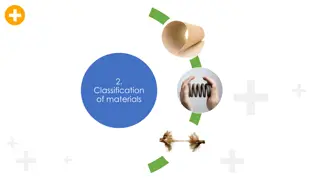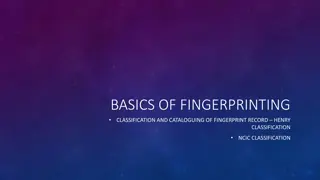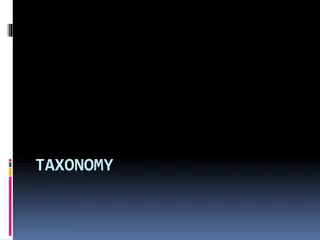
Systematic Classification of Materials in Commerce
Explore the systematic division and grouping of materials based on various characteristics, presented by Dr. B. N. Shinde, Assistant Professor at Deogiri College, Aurangabad. Learn about the importance of proper classification for safe storage, handling, and protection of materials. Discover the classification of materials based on nature, manufacturing process, and more in the field of commerce.
Download Presentation

Please find below an Image/Link to download the presentation.
The content on the website is provided AS IS for your information and personal use only. It may not be sold, licensed, or shared on other websites without obtaining consent from the author. If you encounter any issues during the download, it is possible that the publisher has removed the file from their server.
You are allowed to download the files provided on this website for personal or commercial use, subject to the condition that they are used lawfully. All files are the property of their respective owners.
The content on the website is provided AS IS for your information and personal use only. It may not be sold, licensed, or shared on other websites without obtaining consent from the author.
E N D
Presentation Transcript
Classification of Material Presented by Dr. B. N. Shinde Assistant Professor Department of Commerce Deogiri College, Aurangabad
Classification of Material Classification refers to the systematic division, grouping or categorization of materials or store items with reference to some common characteristic. Classification of materials can be made on different bases namely nature, manufacturing process, value, purpose etc. For identification of materials being purchased and stored it is necessary that they should be properly classified. The store in charge should make a close study of the materials during the process of storage for the purpose of their (i) Safe custody, (ii) Meticulous handling and storing, and (iii) Protection from damages, fire, spoilage, etc. He is responsible for the classification of the materials
Basis of Classification Of Material 1. On the basis of nature: Materials may be divided into: (i) Direct Materials: Direct materials are those items of material which can be identified with a product or a group of products in a manufacturing concern and can be easily measured and charged directly to the product. Such materials form the part of the finished product e.g., timber in furniture, cloth in garments, bricks, sand and cement in building, yarn in cloths etc.
Continue (ii) Indirect Materials: These are the materials which cannot be traced to a specific product and cannot be charged directly to the various products. These materials do not form part of the product. Examples of indirect materials are repair and lubricating oils, cleaning materials, cotton rags etc. maintenance stores,
Continue 2. On the Basis of Manufacturing Process: On the basis of the manufacturing process, stores are divided into: (i) Pre-process Stock: These are the items of stores which are yet to be taken into the manufacturing process and are obtained prior to the commencement of the manufacturing process or production. These include raw materials, bought-outparts and assemblies, and stock in pipeline of materials in transit.
Continue (ii) Intermediate Stock: Intermediate stock comprises the parts or assemblies which are manufactured within the factory for use in the final product. (iii) Finished Goods or Finished Products: As the name indicates, finished goods are the items which have been duly manufactured in the factory and are ready for shipment or sale to the customers.
Continue 3. On the Basis of Value On the basis of the value, the stores items may be divided into: (i) Category A : Category A consists of materials which constitute 5% to 10% of the total items in the stores and represent 70% to 85% of the total stores value. (ii) Category B : This category consists of materials which constitute 10% to 20% of the total items in the stores and also represent 10% to 20% of the total stores value.
Continue (iii) Category C : This category consists of cheap materials which constitute 70% to 85% of the total items in the stores and represent 5% to 10% of the total stores value. Category A items constitute costly items calling for greater degree of control for preserving them. A reasonable degree of care may be taken to control category B items while a routine type of care may be applied to control C category or residuary items.
Continue 4. On the Basis of Movement of Stores: On the basis of the movement or rate of consumption, stores items may be divided into: (i) Fast Moving Stock: Fast moving stock indicates the items of materials which exhaust at a very fast speed on account ofhigh demand from production departments of a manufacturing concern.
Continue (ii) Slow Moving Stock: This category indicates the items of stores or materials which are consumed or exhausted at a very slow speed on account of low demand from the production departments of the manufacturing concern. (iii) Dormant Stock: This category covers stores items which do not have any demand at present and may regain demand in future. This category includes seasonal materials which are required during specified seasons.
Continue Codification is the process of assigning a number or symbol to each store item in addition to its name for making its identification easy and convenient. Codification of store items leads to saving in time and labour on account of substitution of a symbol or number for a longer name. There are different kinds of store codes in use and most of them are specially designed to suit the requirements of a particular organization. These codes may be based upon the nature of stock items, the purpose for which these items are used or on any other basis which is considered as suitable according to the local circumstances.
Systems of Codification The common code systems, among the many used for stores (materials) are given below: 1. Alphabetic system, 2. Simple numeric or sequence system, 3.Combination system, 4.Block system, 5.Decimal system, 6. Numerical system, 7.Mnemonic system and 8. Six letter nine letter codes.
Continue 1. Alphabetic System Letters are chosen to represent particular classification. Alphabet code has 26 letters. Each position in the code has 26 possible letters, where relatively few classification are involved, assignment of letter designates is sometimes arbitrarily made. 2. Simple Numeric or Sequence System Numbers are assigned for classification. The obvious disadvantage of this simple numerical sequence is that there are no memory adds incorporated in the system. A good deal of time is wasted in aching for code numbers in materials code books.
Continue 3. Combination System Some firms find it advantageous to combine a mnemonic and numerical or decimal system. 4. Block System Blocks of numbers are reserved for specified classifications such as 1700-1799 for the raw materials and 1800-1899 for manufacturing parts, etc. The advantage by doing so is that wherever numbers are not assigned, subsequent expansion can be accommodated.
Continue 5. Decimal System Numbers are assigned in such a manner that each digit represents a sub-group or sub-account of the previous digit. The principal advantage of a decimal system is its capacity to accommodate a new item. The disadvantage is that it becomes cumbersome when a basic unit has many minor assemblies which in turn consists of numerous sub- assemblies. 6. Numeric System The first or basic numbers indicate specific classes with subsequent digits used to describe sub-classifications.
Continue 7. Mnemonic System It is an alphabetic system designed with an objective of easy memorization. 8. Six Letter or Nine Letter Codes This system is widely adopted and is of immense use.






















